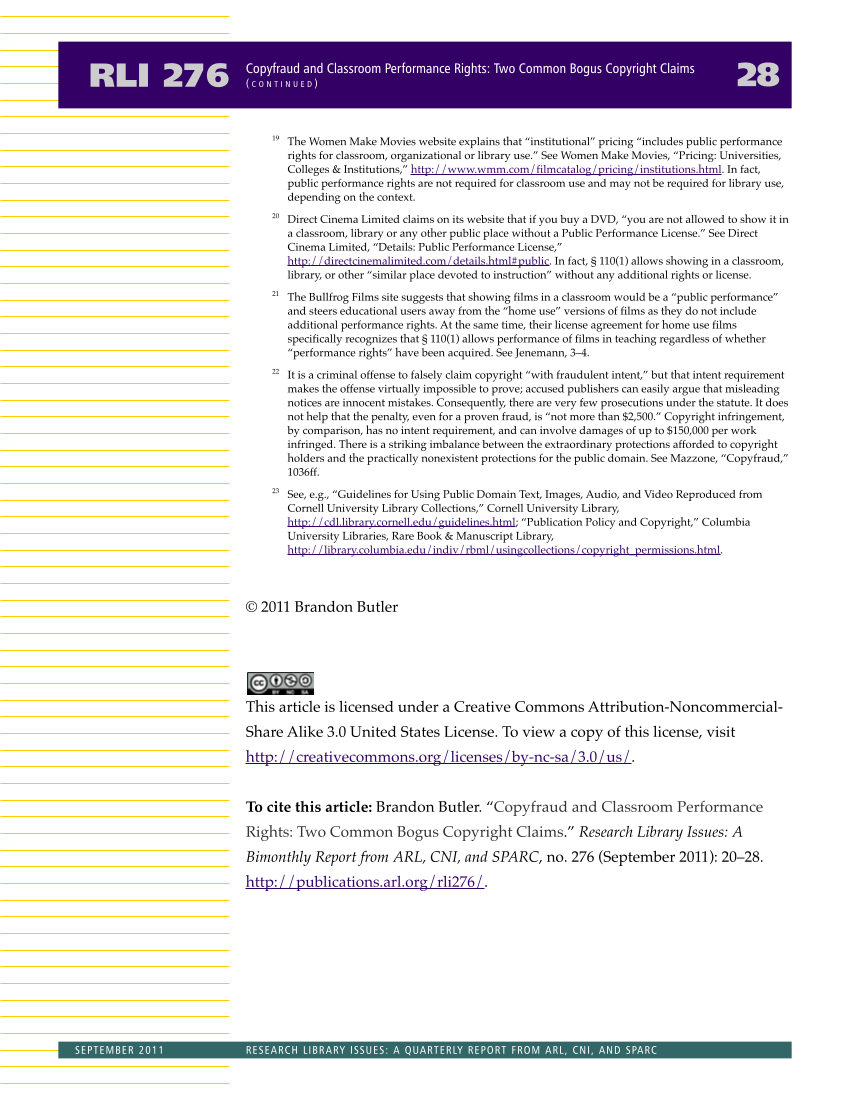19 The Women Make Movies website explains that “institutional” pricing “includes public performance rights for classroom, organizational or library use.” See Women Make Movies, “Pricing: Universities, Colleges & Institutions,” http://www.wmm.com/filmcatalog/pricing/institutions.html. In fact, public performance rights are not required for classroom use and may not be required for library use, depending on the context. 20 Direct Cinema Limited claims on its website that if you buy a DVD, “you are not allowed to show it in a classroom, library or any other public place without a Public Performance License.” See Direct Cinema Limited, “Details: Public Performance License,” http://directcinemalimited.com/details.html#public. In fact, § 110(1) allows showing in a classroom, library, or other “similar place devoted to instruction” without any additional rights or license. 21 The Bullfrog Films site suggests that showing films in a classroom would be a “public performance” and steers educational users away from the “home use” versions of films as they do not include additional performance rights. At the same time, their license agreement for home use films specifically recognizes that § 110(1) allows performance of films in teaching regardless of whether “performance rights” have been acquired. See Jenemann, 3–4. 22 It is a criminal offense to falsely claim copyright “with fraudulent intent,” but that intent requirement makes the offense virtually impossible to prove accused publishers can easily argue that misleading notices are innocent mistakes. Consequently, there are very few prosecutions under the statute. It does not help that the penalty, even for a proven fraud, is “not more than $2,500.” Copyright infringement, by comparison, has no intent requirement, and can involve damages of up to $150,000 per work infringed. There is a striking imbalance between the extraordinary protections afforded to copyright holders and the practically nonexistent protections for the public domain. See Mazzone, “Copyfraud,” 1036ff. 23 See, e.g., “Guidelines for Using Public Domain Text, Images, Audio, and Video Reproduced from Cornell University Library Collections,” Cornell University Library, http://cdl.library.cornell.edu/guidelines.html “Publication Policy and Copyright,” Columbia University Libraries, Rare Book & Manuscript Library, http://library.columbia.edu/indiv/rbml/usingcollections/copyright_permissions.html. © 2011 Brandon Butler This article is licensed under a Creative Commons Attribution-Noncommercial- Share Alike 3.0 United States License. To view a copy of this license, visit http://creativecommons.org/licenses/by-nc-sa/3.0/us/. To cite this article: Brandon Butler. “Copyfraud and Classroom Performance Rights: Two Common Bogus Copyright Claims.” Research Library Issues: A Bimonthly Report from ARL, CNI, and SPARC, no. 276 (September 2011): 20–28. http://publications.arl.org/rli276/. RLI 276 28 Copyfraud and Classroom Performance Rights: Two Common Bogus Copyright Claims ( C O N T I N U E D ) SEPTEMBER 2011 RESEARCH LIBRARY ISSUES: A QUARTERLY REPORT FROM ARL, CNI, AND SPARC


































